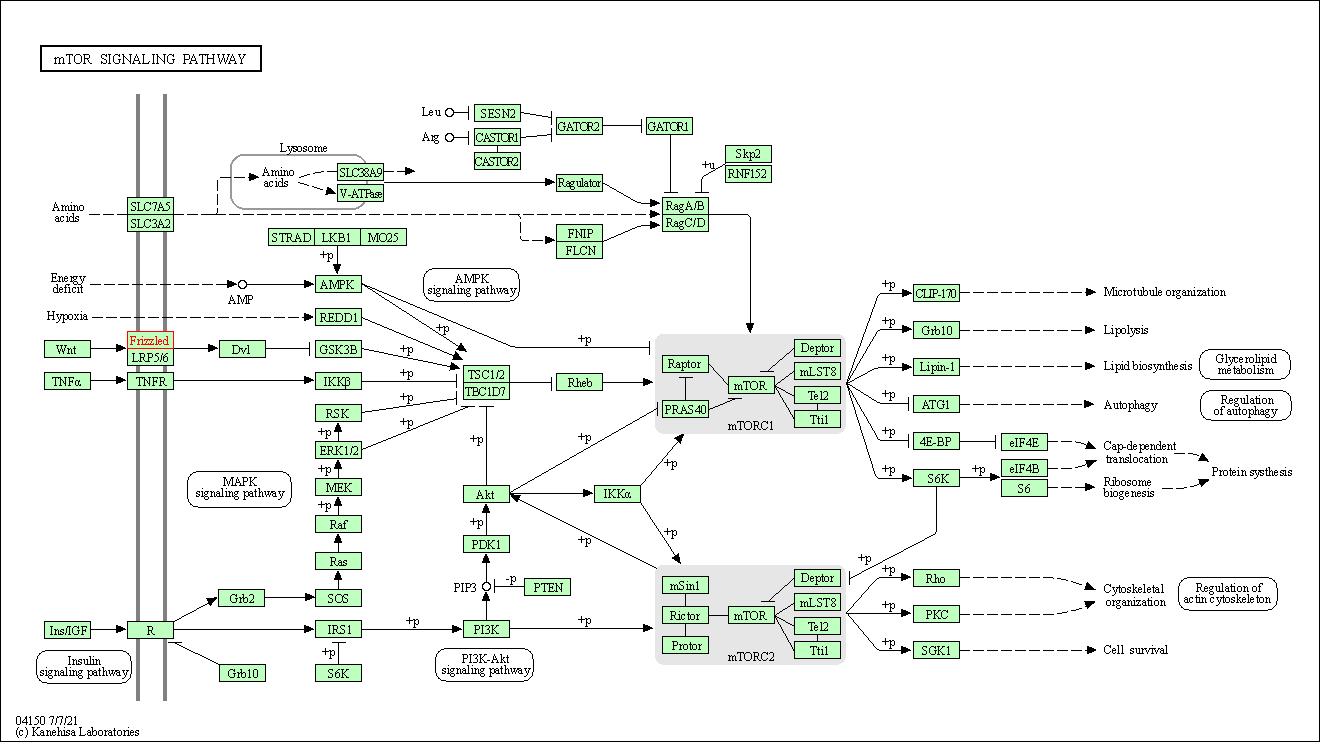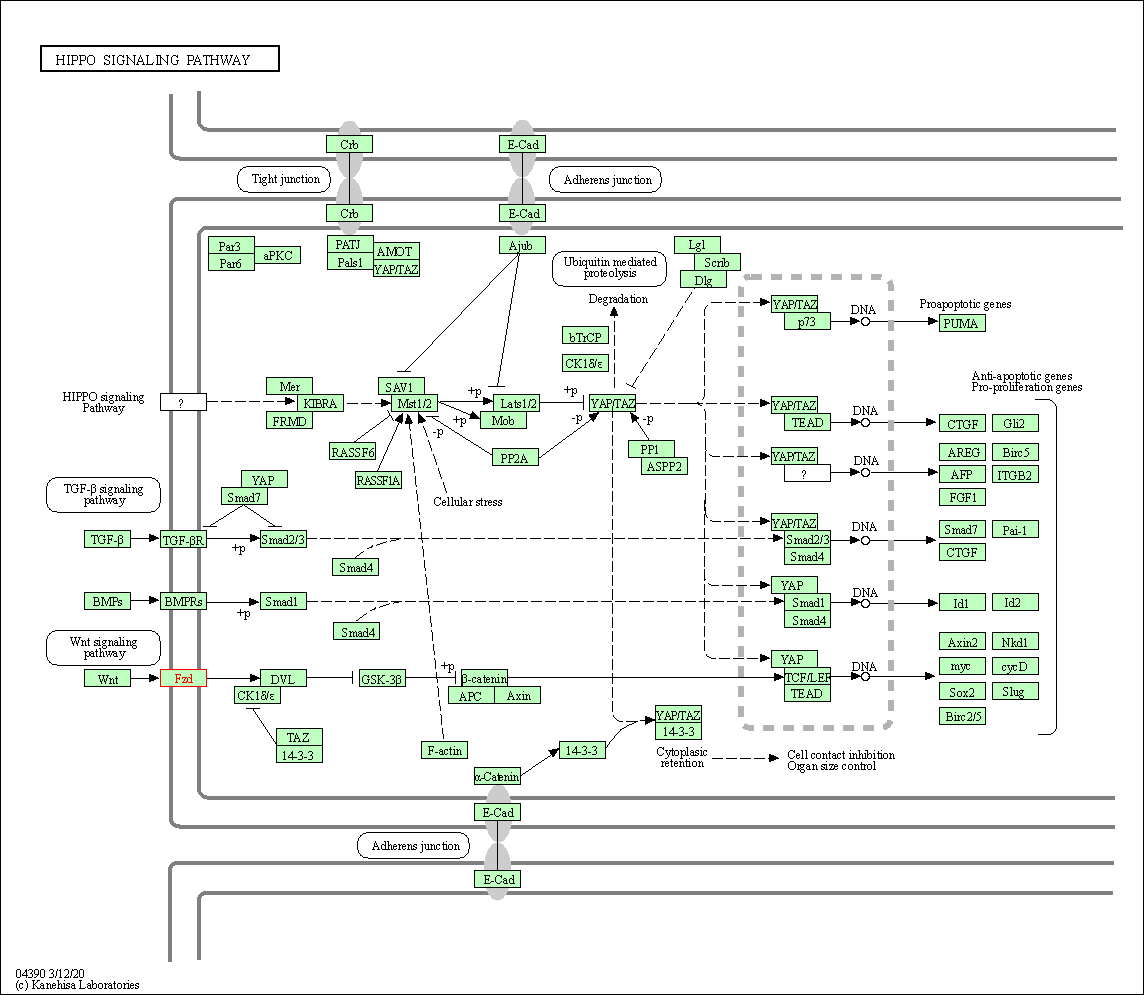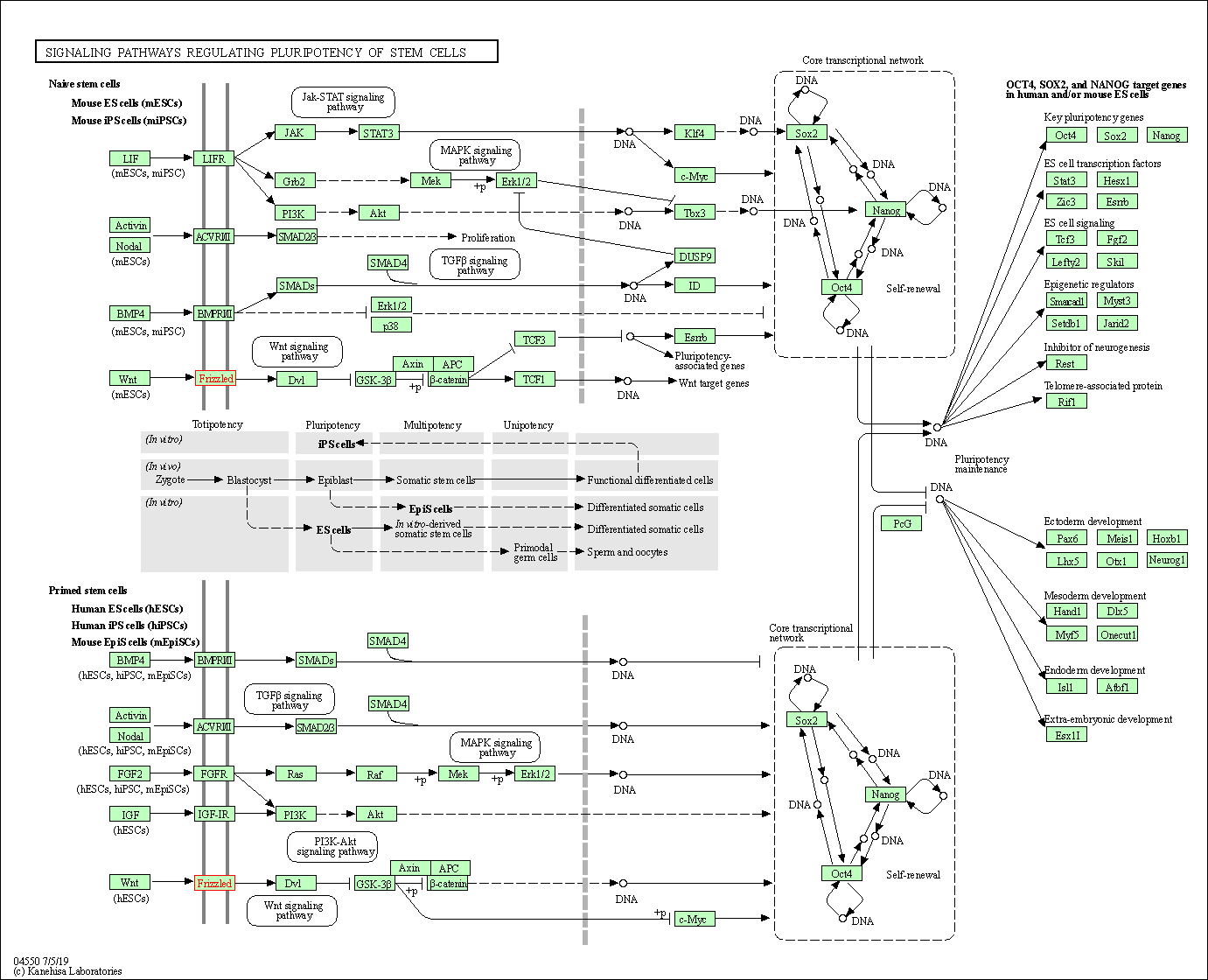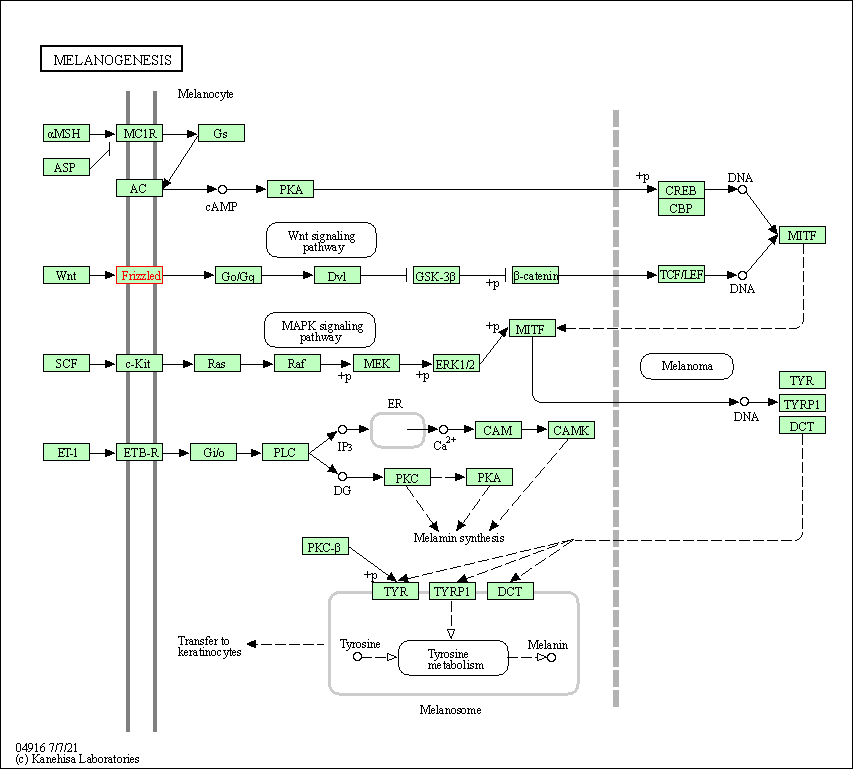Target Information
| Target General Information | Top | |||||
|---|---|---|---|---|---|---|
| Target ID |
T59702
|
|||||
| Target Name |
Frizzled-10 (FZD10)
|
|||||
| Synonyms |
Fz-10; hFz10; FzE7; DE AltName: CD_antigen=CD350
Click to Show/Hide
|
|||||
| Gene Name |
FZD10
|
|||||
| Target Type |
Clinical trial target
|
[1] | ||||
| Disease | [+] 1 Target-related Diseases | + | ||||
| 1 | Synovial sarcoma [ICD-11: 2B5A] | |||||
| Function |
Receptor for Wnt proteins. Functions in the canonical Wnt/beta-catenin signaling pathway (By similarity). The canonical Wnt/beta-catenin signaling pathway leads to the activation of disheveled proteins, inhibition of GSK-3 kinase, nuclear accumulation of beta-catenin and activation of Wnt target genes. A second signaling pathway involving PKC and calcium fluxes has been seen for some family members, but it is not yet clear if it represents a distinct pathway or if it can be integrated in the canonical pathway, as PKC seems to be required for Wnt-mediated inactivation of GSK-3 kinase. Both pathways seem to involve interactions with G-proteins. May be involved in transduction and intercellular transmission of polarity information during tissue morphogenesis and/or in differentiated tissues (Probable).
Click to Show/Hide
|
|||||
| UniProt ID | ||||||
| Sequence |
MQRPGPRLWLVLQVMGSCAAISSMDMERPGDGKCQPIEIPMCKDIGYNMTRMPNLMGHEN
QREAAIQLHEFAPLVEYGCHGHLRFFLCSLYAPMCTEQVSTPIPACRVMCEQARLKCSPI MEQFNFKWPDSLDCRKLPNKNDPNYLCMEAPNNGSDEPTRGSGLFPPLFRPQRPHSAQEH PLKDGGPGRGGCDNPGKFHHVEKSASCAPLCTPGVDVYWSREDKRFAVVWLAIWAVLCFF SSAFTVLTFLIDPARFRYPERPIIFLSMCYCVYSVGYLIRLFAGAESIACDRDSGQLYVI QEGLESTGCTLVFLVLYYFGMASSLWWVVLTLTWFLAAGKKWGHEAIEANSSYFHLAAWA IPAVKTILILVMRRVAGDELTGVCYVGSMDVNALTGFVLIPLACYLVIGTSFILSGFVAL FHIRRVMKTGGENTDKLEKLMVRIGLFSVLYTVPATCVIACYFYERLNMDYWKILAAQHK CKMNNQTKTLDCLMAASIPAVEIFMVKIFMLLVVGITSGMWIWTSKTLQSWQQVCSRRLK KKSRRKPASVITSGGIYKKAQHPQKTHHGKYEIPAQSPTCV Click to Show/Hide
|
|||||
| 3D Structure | Click to Show 3D Structure of This Target | AlphaFold | ||||
| Drugs and Modes of Action | Top | |||||
|---|---|---|---|---|---|---|
| Clinical Trial Drug(s) | [+] 1 Clinical Trial Drugs | + | ||||
| 1 | OTSA-101-DTPA-90Y | Drug Info | Phase 1 | Synovial sarcoma | [2] | |
| Cell-based Target Expression Variations | Top | |||||
|---|---|---|---|---|---|---|
| Cell-based Target Expression Variations | ||||||
| Different Human System Profiles of Target | Top |
|---|---|
|
Human Similarity Proteins
of target is determined by comparing the sequence similarity of all human proteins with the target based on BLAST. The similarity proteins for a target are defined as the proteins with E-value < 0.005 and outside the protein families of the target.
A target that has fewer human similarity proteins outside its family is commonly regarded to possess a greater capacity to avoid undesired interactions and thus increase the possibility of finding successful drugs
(Brief Bioinform, 21: 649-662, 2020).
Human Pathway Affiliation
of target is determined by the life-essential pathways provided on KEGG database. The target-affiliated pathways were defined based on the following two criteria (a) the pathways of the studied target should be life-essential for both healthy individuals and patients, and (b) the studied target should occupy an upstream position in the pathways and therefore had the ability to regulate biological function.
Targets involved in a fewer pathways have greater likelihood to be successfully developed, while those associated with more human pathways increase the chance of undesirable interferences with other human processes
(Pharmacol Rev, 58: 259-279, 2006).
Biological Network Descriptors
of target is determined based on a human protein-protein interactions (PPI) network consisting of 9,309 proteins and 52,713 PPIs, which were with a high confidence score of ≥ 0.95 collected from STRING database.
The network properties of targets based on protein-protein interactions (PPIs) have been widely adopted for the assessment of target’s druggability. Proteins with high node degree tend to have a high impact on network function through multiple interactions, while proteins with high betweenness centrality are regarded to be central for communication in interaction networks and regulate the flow of signaling information
(Front Pharmacol, 9, 1245, 2018;
Curr Opin Struct Biol. 44:134-142, 2017).
Human Similarity Proteins
Human Pathway Affiliation
Biological Network Descriptors
|
|
|
There is no similarity protein (E value < 0.005) for this target
|
| KEGG Pathway | Pathway ID | Affiliated Target | Pathway Map |
|---|---|---|---|
| mTOR signaling pathway | hsa04150 | Affiliated Target |

|
| Class: Environmental Information Processing => Signal transduction | Pathway Hierarchy | ||
| Wnt signaling pathway | hsa04310 | Affiliated Target |

|
| Class: Environmental Information Processing => Signal transduction | Pathway Hierarchy | ||
| Hippo signaling pathway | hsa04390 | Affiliated Target |

|
| Class: Environmental Information Processing => Signal transduction | Pathway Hierarchy | ||
| Signaling pathways regulating pluripotency of stem cells | hsa04550 | Affiliated Target |

|
| Class: Cellular Processes => Cellular community - eukaryotes | Pathway Hierarchy | ||
| Melanogenesis | hsa04916 | Affiliated Target |

|
| Class: Organismal Systems => Endocrine system | Pathway Hierarchy | ||
| Degree | 2 | Degree centrality | 2.15E-04 | Betweenness centrality | 0.00E+00 |
|---|---|---|---|---|---|
| Closeness centrality | 1.85E-01 | Radiality | 1.31E+01 | Clustering coefficient | 1.00E+00 |
| Neighborhood connectivity | 1.90E+01 | Topological coefficient | 5.43E-01 | Eccentricity | 13 |
| Download | Click to Download the Full PPI Network of This Target | ||||
| References | Top | |||||
|---|---|---|---|---|---|---|
| REF 1 | A first-in-human study investigating biodistribution, safety and recommended dose of a new radiolabeled MAb targeting FZD10 in metastatic synovial sarcoma patients. BMC Cancer. 2018 Jun 8;18(1):646. | |||||
| REF 2 | ClinicalTrials.gov (NCT01469975) First in Man Study Investigating the Biodistribution, the Safety and Optimal Recommended Dose of a New Radiolabelled Monoclonal Antibody Targeting Frizzled Homolog 10 (SYNFRIZZ). U.S. National Institutes of Health. | |||||
If You Find Any Error in Data or Bug in Web Service, Please Kindly Report It to Dr. Zhou and Dr. Zhang.

